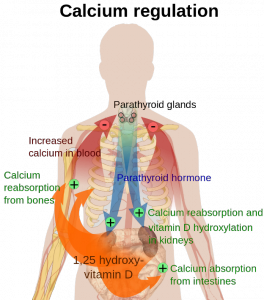What are the Parathyroid Glands and what do they do?

Author: BodyParts3D is made by DBCLS
The thyroid gland is a butterfly shaped gland that is located in front of your trachea (windpipe). The parathyroid glands are four glands located behind the thyroid gland in the neck. The parathyroid glands are the smallest glands in the body – they are about the size of a grain of rice. Although the parathyroid glands lay behind the thyroid, they do not have any direct relationship to one another.
The parathyroid glands are responsible for producing parathyroid hormone (PTH) which exists to help regulate calcium levels in the bloodstream.
When the calcium level in the blood is low:
The parathyroid glands sense low calcium and produce PTH. Parathyroid hormone then acts on the bones to release calcium as well as phosphorus. PTH also acts on the kidneys to decrease the excretion of calcium, increase the production of Vitamin D and increase calcium absorption from the gut.
Parathyroid hormone works together with another hormone called Calcitonin to regulate your body’s calcium level and maintain healthy bones.
When the calcium level in the blood is high:
Normal parathyroid glands stop producing PTH.
Hyperparathyroidism occurs when PTH is produced in excess (overactive PTH production). This may lead to thinning of the bones (osteopenia or osteoporosis), kidney stones, abdominal discomfort, and general anxiety.
PTH & Calcium Cycle
 The major function of the parathyroid glands is to maintain the body’s calcium level in both the blood and bones. There is a narrow range of calcium required for the nervous and muscular systems to function properly. (A normal calcium level in the blood stream ranges from 8.5-10.2 mg/dL ). When blood calcium levels drop below a certain level, receptors in the parathyroid gland release parathyroid hormone (PTH) in proportion to the amount of calcium that is required by the body. This hormone increases blood calcium levels by stimulating osteoclasts to release calcium by breaking down bone. Osteoclasts are cells in the bones that break down and remodel bone tissue.
The major function of the parathyroid glands is to maintain the body’s calcium level in both the blood and bones. There is a narrow range of calcium required for the nervous and muscular systems to function properly. (A normal calcium level in the blood stream ranges from 8.5-10.2 mg/dL ). When blood calcium levels drop below a certain level, receptors in the parathyroid gland release parathyroid hormone (PTH) in proportion to the amount of calcium that is required by the body. This hormone increases blood calcium levels by stimulating osteoclasts to release calcium by breaking down bone. Osteoclasts are cells in the bones that break down and remodel bone tissue.
When the body’s calcium metabolism is in balance, there is an even amount of bone breakdown and bone building so that the calcium storage in our body remains even and the bones remain dense and strong.
An elevated PTH level is not normal and should be investigated. The normal level of PTH in the blood stream is between 10-65 picograms per milliliter (pg/mL) in most laboratories. When one or more of the parathyroid glands produce too much PTH, the excess hormone removes calcium from the bones and adds it to the blood. The bone calcium loss eventually causes osteoporosis.
PTH & Vitamin D
 PTH also activates Vitamin D, which helps the intestine to absorb calcium from food. Vitamin D promotes calcium reabsorption by the kidneys. Hyperparathyroidism causes a decrease in the body’s Vitamin D available for the intestines. This, in turn, reduces the amount of calcium that can be absorbed from a person’s diet.
PTH also activates Vitamin D, which helps the intestine to absorb calcium from food. Vitamin D promotes calcium reabsorption by the kidneys. Hyperparathyroidism causes a decrease in the body’s Vitamin D available for the intestines. This, in turn, reduces the amount of calcium that can be absorbed from a person’s diet.


